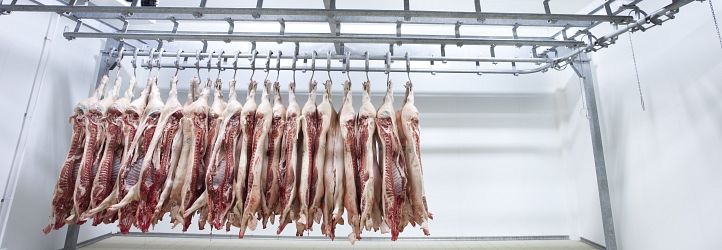Understanding the correct meat storage procedures whether frozen or chilled, is important if you want produce that is as fresh, delicious and safe as possible.
Harmful bacteria begin to develop in raw meat from the moment an animal is slaughtered, making storage an incredibly time sensitive process. If you want or need to prolong the life of your meat for as long as possible, it’s crucial that you follow the correct safe storage procedures.
In this handy meat cold storage guide you will find out:
- Freezing temperatures for meats
- How long can you freeze meats for?
- How long can I keep meats in the fridge?
- Meat storage temperatures
- How to safely store meat
- How can I store meat cost effectively?
From the optimum storage temperatures for chilled and frozen meat, to the most cost effective ways to store it, this guide will help you to make the most out of your meat.

1. Freezing temperatures for meats
To maintain maximum freshness, meat should be frozen as quickly as possible. This is important to retain the flavour, texture and aesthetics of the produce, as well as to inhibit the growth of bad bacteria.
If you work in the food industry, serving up the safest and freshest meat should be a priority. This is why many restaurant and catering businesses invest in blast freezers, which can freeze meats quickly and effectively.
At the very minimum, your meats should be frozen at a temperature of -18°C. This temperature is considered best practice for frozen
meat storage and ensures
that the
harmful pathogen growth is inhibited. It is required by law to keep raw meats at this temperature when frozen to protect customers from harmful bacteria and food borne illnesses.
It’s important to note that -18°C is actually the minimum temperature required by regulations and anything found to be warmer than this should not be served.
Alongside following health and safety regulations, a temperature of -18°C allows caterers, cooks and restaurant owners to store meat safely and effective over longer periods.
2. How long can you freeze meats for?
The first thing to understand when considering storage options is that not all meats are equal and that their storage times reflect this. It’s important to remember that the fat and water content, as well as the size of the cut, will change how long a piece of meat should be stored for in a blast freezer.
These timings are a good indication of how long regular cuts of meat will stay fresh at -18°C if storage procedures, up until this point, have been followed correctly.

Beef and lamb generally have a longer storage time because they are made up of hard fats, which are partially saturated. However younger meats, such as veal and pork, will deteriorate much faster as they have a lower level of saturated fat.
Larger cuts of meat will almost always have a smaller storage time, as they take longer to blast freeze initially.
Alongside this, you should be careful never to overfill your cold storage container as this can cause meat to freeze slowly or unevenly, leaving your customers susceptible to food borne illness.
These guidelines are guidelines only and proper safety and quality control checks should always be undertaken before meat is served to customers.
3. How long can I keep meats in the fridge?

Regular fridges are not as effective as commercial refrigerated containers and therefore, safe storage can be a lottery. For those working in the food industry, whether in a restaurant, school or catering business, a refrigerated container is a must.
Meat should always be consumed as soon as possible after purchase for optimal flavour and texture but consuming meat sooner, rather than later will also decrease the risk of a person ingesting harmful bacteria.
As a rule of thumb, meats like beef and pork mince should not be kept refrigerated any longer than 1-2 days. This is because harmful bacteria begin to develop immediately after slaughter and the mincing process can accelerate this.
Other cuts of meat, such as steaks and pork chops, can be kept refrigerated for a little longer, especially if they have a higher fat content. These cuts are generally fridge safe for about 3-4 days, any longer and you’ll likely have a bacteria problem.
Remember to always trust your senses when it comes to meat, as some products will spoil more quickly or more slowly than others. Use your eyes and your nose to check produce and if you are unsure, it’s safest to not take the risk.
If you aren’t planning to serve meat within these timescales, it’s always best to freeze produce to keep it at its safest and tastiest.
4. Meat storage temperatures
Bacteria develop incredibly quickly in raw, unfrozen meat and should therefore be used with great care. The best practice temperature for storing raw meats should be followed meticulously if you want to keep food wastage to a minimum and prevent the threat of illness.
Chilled meat and poultry, which is kept in a refrigerated container, should be stored at a temperature no higher than 4°C to effectively inhibit the growth of dangerous pathogenic bacteria.
Anything warmer than this and you could be seriously risking the health of your customers, so it is never wise to take a chance on improperly stored meat. Much like the frozen storage best practice, this temperature is an absolute minimum and efforts should always be made to keep meats as cold as possible.
Refrigerated containers are the safest and easiest way to store chilled meats in the correct manner. Offering a temperature controlled environment, you can be certain that your meat meets the standards set out by the government for safe meat storage.
With commercial cold storage, you can ensure that your meat goes above and beyond what is required and offer your customers a safer and more superior tasting product.
5. How to safely store meat
Storing meat safely within refrigerated containers and blast freezers is essential if you want to minimise loss from product spoilage and ensure that meat is safe for customers to consume once it reaches its final destination.
The first thing to remember is that you should always be sure to not overfill your cold storage above the recommended weights. This can cause meat to freeze more slowly, leaving you with produce that is not fit for consumption.
Alongside this, you should also ensure that employees are following the correct safety procedures, such as hand washing and glove wearing where appropriate. Safe handling practices go some way to make sure that meat is being stored in a safe manner.
When storing chilled raw meat, it’s important to keep it well wrapped and away from other non-meat foods, so that there is no chance of cross-contamination.
If you are storing more than one type of product in a blast freezer or refrigerated container, you must always keep meat produce low down to avoid any drips from leaking packaging.
6. How can I store meat cost effectively?
Working in the food industry, it’s important to make your food go as far as possible. Wasted food stops your business from being profitable but with the help of a blast freezer or refrigerated container, you can keep produce fresher for longer periods of time. You can increase your profits and serve food to your customers without the worry of tainted produce.
Blast freezing meat is a quick and reliable way of preserving produce for a future date. This gives restaurant owners and caterers the option to confidently buy in bulk, saving future time and money.
It’s also a fantastic option if you want to portion out food precisely and store each ‘meal’ in advance until you are ready to serve.
After blast freezing, simply defrost any meat as usual and you’re left with a fresh cut you can serve to your customers.
If you’re establishment prefers not to freeze food, a refrigerated container is another helpful option for larger amounts of meat.Bulk storage can be difficult in regular refrigerators but with a temperature controlled refrigerated container, you can easily portion up and store fresh food. This option minimises food wastage, thus helping you to store food more cost effectively.
If you are currently storing your meat products in large central cold store; check that the price per pallet storage and the price per pallet to blast chill is as cost effective as a mobile cold store.
With a cold Store the price per pallet should be more cost effective while also allowing you to maintain quality and reduce transport costs due to storing on your site in a mobile colds store. While you should also reduce delays in getting your product which sometimes happens in larger central storage and distribution centres.
Want to find out more about commercial, bulk meat freezing? See our meat cold storage page or get in touch with CRS on 0800 085 2298













